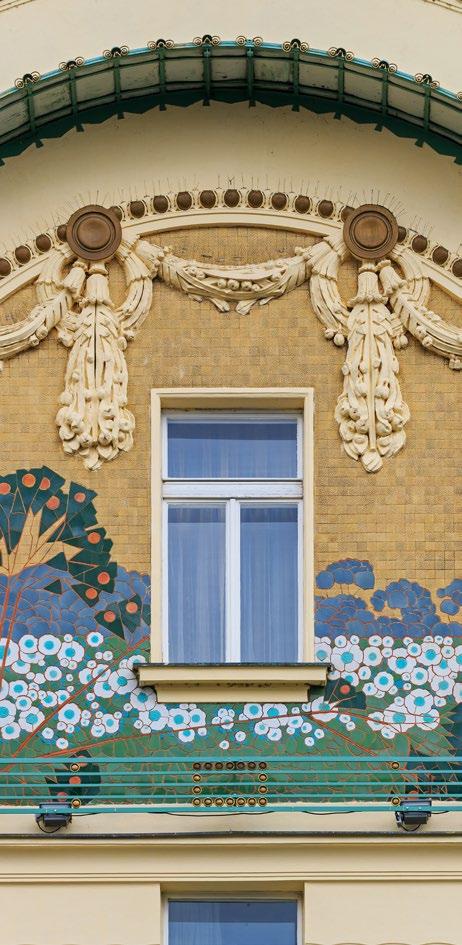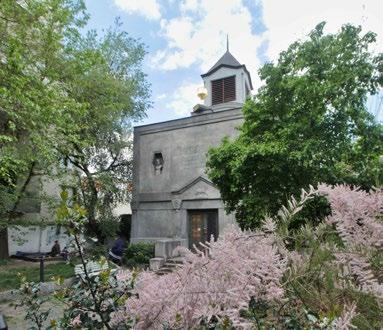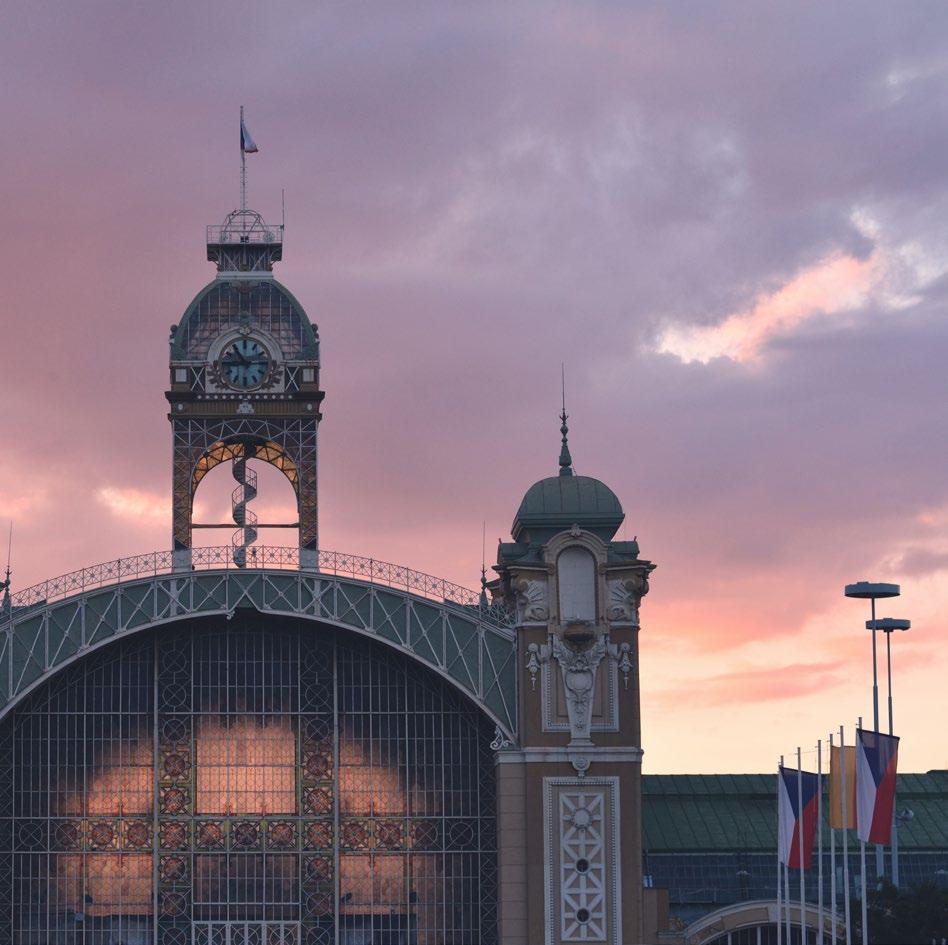
8 minute read
In search of Art Nouveau Prague
Any mention of Art Nouveau Prague is bound to conjure up the breath-taking Municipal House or the historic building of the Prague Main Railway Station with Fantova kavárna café taking pride of place. Yet our metropolis is dotted with many other buildings in this inspired architectural style, be they houses and villas, churches or technical heritage monuments. Their ornamental façades with often quite playful colours and asymmetrical shapes warm the hearts of many an appreciative onlooker.
Alfons Mucha: from the Four Seasons cycle commons.wikimedia.org
Encyclopaedias characterize Art Nouveau as an international art movement of the turn of the 19th and 20th centuries, striving for a new kind of artistic expression, quite different from the then prevailing historicist approach. Its main features include ornate two-dimensionality and a penchant for unusual colours and hues. Its hallmark is curvilinearity, stylized towards natural or symbolized shapes (leaves, flowers, human and animal bodies). Enough of the scholarly digression.
Best of the Best
This modern and for its time free-thinking architecture surged through Europe like an avalanche and the cities of Austria-Hungary were certainly not left out. As for Prague, Art Nouveau made a very marked impression on the architectural visage of the city – we can count some 40 buildings in this style in the metropolis today. And, as we indicated in our introduction, they cover the whole range of building types. The more well-known buildings include the aforementioned Municipal House and the Fantova kavárna building at the Main Railway Station. The interior of the Municipal House (architects A. Balšánek and O. Polívka; decoration by A. Mucha, M. Švabinský, J. V. Myslbek, M. Aleš, etc.) comprises a restaurant, a café, and several halls, the largest of which is the monumental Sme-
Alois Dryák: The façade of Hotel Meran in Prague A. Savin, commons.wikimedia.org
tana Hall, serving as a sumptuous concert space for about 1,200 concert-goers (the majority of concerts are hosted by the Prague Symphony Orchestra). There are guided tours of the whole heritage site, fit for true Art Nouveau aficionados. The showy buildings of the Main Station (architect J. Fanta; decoration by S. Sucharda, L. Šaloun, etc.) are currently undergoing a costly renovation to bring back their original lustre. It is not without interest that the historical building and the hall above the train lines amount to what is the most monumental Art Nouveau construction in the Czech Republic. Few people know that Prague has another Art Nouveau railway station – at Prague-Vyšehrad. Unfortunately, this valuable cultural monument has been dilapidating for many years, leading to its present sorry state.
Fantova kavárna café at the Main Railway Station


The Smetana Hall of the Municipal House

Hotels and Churches
Hotels are in a distinctive class of their own among Prague’s Art Nouveau architecture – most notably the Hotel Evropa on Wenceslas Square, Hotel Paris (adjacent to the Municipal House) with the beautiful Sarah Bernhardt restaurant, the five-star Art Nouveau Palace Hotel on the corner of Jindřišská and Panská streets, Hotel Union on Ostrčilova square, Hotel & Café Imperial, whose architecture is an extraordinary mix of Art Nouveau and Art Deco, and Hotel Central in Hybernská street. All of them are characterized by a wonderfully colourful interior and outer décor with ornate elements, perfectly livening up their urban surroundings. Art Nouveau styled Churches are undoubtedly among its most remarkable examples. They are not plentiful, but they are all worth seeing. Among the most prominent representatives is the three-nave temple of St Anna in Žižkov in Ostromečská street, built in the so-called Beuroner Schule, Vienna Secession style. This place of worship has been protected as a cultural heritage monument since 2002, together with its adjacent Carmelite Monastery. It is also worth mentioning the Church of St Wenceslas in the grounds of Bohnice psychiatric hospital. It currently serves not only for religious services, but also as an unconventional space for concerts and other cultural events, not just for the hospital, but also for the general public. The wooden Church of St Adalbert in Libeň, built in 1905 to the design of wellknown architect Emil Králíček, is exceptional in many ways. With its neighbouring Libeňská Sokolovna sports hall (by the same architect), the St Adalbert Church forms a charming ‘Art Nouveau cameo’. Prague’s quartet of sacral buildings built in the Art Nouveau style is rounded off by the Bethlehem Chapel in Žižkov (Prokopova 10), where the Evangelical Church of Czech Brethren officiates. This at first glance inconspicuous but elegant structure surrounded by apartment buildings is extraordinary in how it combines elements of late Art Nouveau and Cubism.
The Bethlehem Chapel in Žižkov VitVit, commons.wikimedia.org

Hotel & Cafe Imperial

vila Karla Vítězslava Maška

The Flamboyant Beauty of (not only) colourful Villas
Let’s take a look at Art Nouveau villas. To list them all would be beyond the scope of this article, so let’s focus only on a few of the most highly prized specimens. Firstly, we must mention Bílkova vila at Hradčany. There may be no other building in Prague with so many symbolic elements encoded in it – taken to such aesthetic perfection. It was designed by sculptor, painter and graphic designer František Bílek (1872–1941) in 1910 to serve as his own residence and studio. Permeating the whole concept is the artist’s inspiration drawn from a field of wheat – the ground plan of the building is like the sweep of a harvesting scythe, the stone columns embody stylized stalks and cobs, and even the flat roof is reminiscent of a field. The villa’s distinctiveness is in part down to the fact that Bílek’s work includes all interiors, including furniture. Today, this architectural gem is part of the exhibits of The Prague City Gallery. As for other interesting buildings, it is definitely worth seeing the set of villas in Bubeneč – for example, Vila Kraus (Na Zátorce 3), which was designed in the style of late geometric Art Nouveau, the vila Karla Vítězslava Maška (Slavíčkova 7) built in the spirit of Art Nouveau folk art or the villa just opposite, decked with ivy, Suchardova vila by the famous architect Jan Kotěra. The picturesque Vila Helenka in Na Václavce street 15 is fabulously picturesque with a distinctive stucco floral decor on a yellow façade. One very unusual and architecturally prized example is the Šalounova vila (Slovenská 6) in Vinohrady, which served as a studio for the sculptor of the same name, after he had won the competition to sculpt the Master Jan Hus Monument on Old Town Square (which, by the way, is also in Art Nouveau style). Back in the day, this soberly conceived building with strong symbolist elements was a popular meeting-place for Prague’s artistic elite.
My House, My Castle
Beautiful examples of Art Nouveau buildings, whose artistry stands comparison with the grandeur of the aforementioned villas, can also be found and admired among Prague town houses. Worth noticing is the Topičův dům house on Národní třída boulevard with its beautifully decorated façade, or the five-storey Adamova lékárna building on Wenceslas Square (No. 8), as well as Peterkův dům (No. 12) nearby. A nice example of an Art Nouveau house can be seen on Senovážné náměstí square (U Tří Jezdců / ‘At
the Three Riders’) or in Vodičkovova street (U Nováků). Štencův dům in Salvatorská street (Prague 1) built in the very different and unadorned style of modern Art Nouveau attracts passers-by with an austere brickwork façade. By contrast, the Spolkový dům Hlahol musical society house in the bloc between the Masarykovo embankment and Vojtěšská street or the nearby Goethe-Institut in Prag (Masarykovo nábřeží 32) are strikingly decorative. And there are others – the Národní dům na Smíchově, the Divadlo Na Vinohradech theatre, the Vršovická záložna credit union, the Nová Strašnická škola school, the Palác Koruna building on Wenceslas Square, etc. – further examples of houses imbued with the unmistakable Art Nouveau form.
Industrial Art Nouveau
It can seem quite unlikely that such a refined and artistically elaborate style has also found its way into Prague’s technical infrastructure buildings. One remarkable building from the era of Czech industrial Art Nouveau is the Old Wastewater Treatment Plant in Prague-Bubeneč. Thanks to its evocative period mood it has become not only a frequent destination for tourist outings, but also a worthy backdrop for various film productions. Adorning the upstream tip of Štvanice Island is a small power station building with a domed tower. From a distance it seems more like a squat, verdigris-hued church building. Another architecturally impressive building is also the Neo-Renaissance and Art Nouveau complex of the Braník brewery and nearby ice-making plant. The only Art Nouveau bridge in the Czech Republic – Prague’s Čechův most – is quite exceptionally ornate. And, of course, let us not forget to mention the Industrial Palace in the Exhibition Grounds, an impressive glass and steel structure.

As you can see, the mark left on Prague architecture by Art Nouveau is quite striking and unmissable. We can thank the whole plethora of excellent architects, builders, painters or sculptors for that specific charm; in short, everyone who helped to make Prague one of the most beautiful cities in Europe.

The Industrial Palace in the Exhibition Grounds






